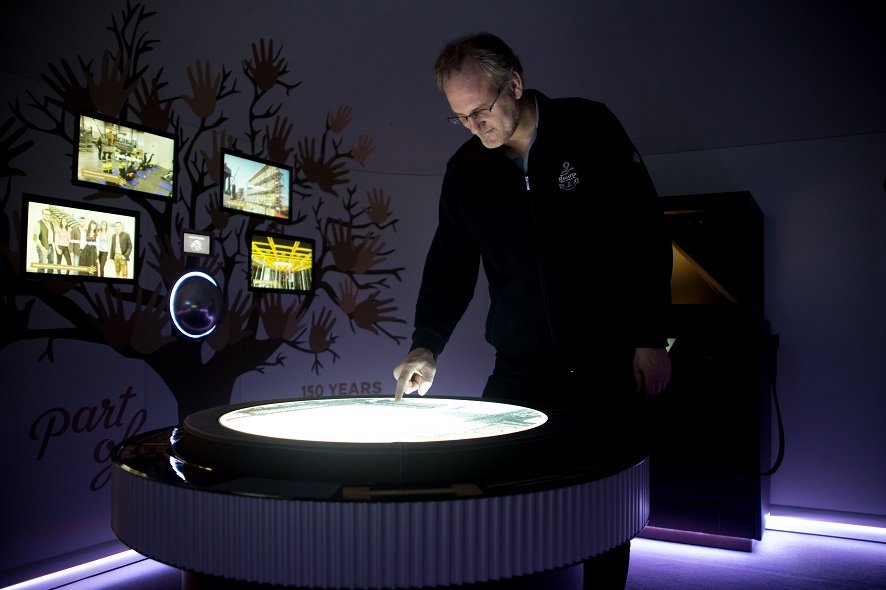The Umdasch Group is celebrating its sesquicentennial! To mark the occasion, the company commissioned Ars Electronica Solutions to design two pavilions for its anniversary exhibition in Vienna’s Weltmuseum. The Pavilion of the Past and Present highlights milestones of the last 150 years, the Umdasch Group’s employees, and the company’s diversified global activities. Juxtaposed to it is the Pavilion of the Future focusing on megatrends of the coming years and decades.
A unique projection-in-the-round, informative holograms, and a meticulously designed, beautifully crafted transparent screen—the individual installations are as diverse as they are sophisticated. In this interview, Ars Electronica Solutions project manager Claus Zweythurm talks about the experience of visiting the Umdasch pavilions in Vienna’s Weltmuseum, the evolution of this anniversary exhibition, and the challenges he and his team faced.
Tell us about the inception of these two pavilions for Umdasch Group in Vienna’s Weltmuseum.
Claus Zweythurm: Stefan Umdasch, founder and director of Umdasch Design, designed two pavilions to celebrate Umdasch Group’s sesquicentennial. Because the company is a sponsor of the Weltmuseum, they were invited to display both pavilions right in the museum. Two spaces were made available in the rotunda immediately adjacent to the spacious staircase leading to the exhibitions, so a lot of pedestrian traffic. Umdasch has taken advantage of this opportunity to present itself to the public. On one hand, this is a very subtle effort to showcase the company’s achievements, but they’re also calling attention to the problems our world is facing. So, Stefan Umdasch had already come up with the pavilions’ design; our assignment was the content inside.
To what extent was Ars Electronica Solutions involved in the pavilions’ design and furnishings?
Claus Zweythurm: We essentially did the technical implementation of the installations in the Pavilion of the Past and Present, both the hardware and software solutions, the content, the interaction concept, and the visitors’ guide. In the Pavilion of the Future, the Stumpfl Company did the technical setup; Ars Electronica Solutions and Umdasch implemented the content.
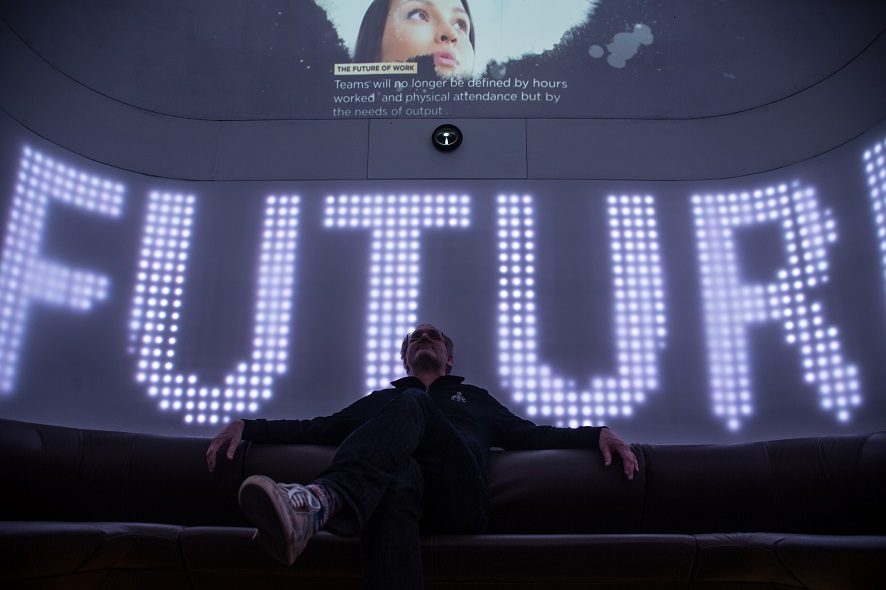
Credit: Vanessa Graf
What do visitors to the Pavilion of the Future experience?
Claus Zweythurm: The Pavilion of the Future is the more passive of the two. Here, visitors can access information that we prepared in cooperation with Umdasch. The point is to select a few megatrends that perhaps also have something to do with Umdasch’s business model—for example, the Future of Work and, above all, Consumption. Two key megatrends are Energy & Resources and Urbanization. In conjunction with these four topics, we build 3-D models that a virtual camera flies through, and thereby plays up potential future scenarios—or even already extant scenarios—that a lot of people aren’t fully cognizant of. It’s a bit like a movie theater.
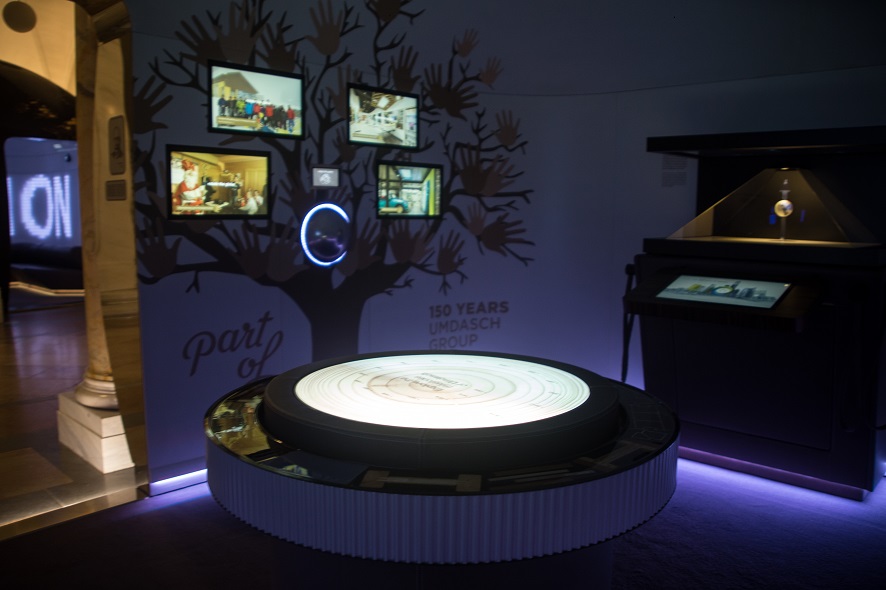
Credit: Vanessa Graf
And what happens in the Pavilion of the Past and Present?
Claus Zweythurm: The centerpiece is a display that shows, in a very understated way, a few of Umdasch’s milestones over the past 150 years. Visitors see the company’s history from 1868 to 2018, with the key junctures during this century and a half. To do this, we used an interesting, newly developed module—a projection-in-the-round. This is unprecedented—a round touchscreen on which users can select various topics or milestones and find out more about the Umdasch Group.
The second installation is dedicated to DOKA, an Umdasch subsidiary that produces casings for scaffolding. For instance, they’re currently being used to construct the world’s tallest building, the Burj Khalifa in Dubai, so we designed an installation with a touchscreen that goes into detail about this skyscraper. Touch technology lets users build the tower themselves—you take the scaffolding, move it upwards, and at each successive station, you find out about the special features of such a project.

Credit: Vanessa Graf
Another installation is dedicated to retail shop construction …
Claus Zweythurm: Exactly. Shopfitting is a small part of Umdasch Group’s business, but it’s a big part of the company’s origins. This is all about making shops and shopping an experience. This installation begins with the story of an employee who got in on the ground floor, Herr Holzapfel, and concludes with the future prospects of a new, young staff member, Frau Babinger. The installation is based on a transparent screen—activating it makes wall prints behind it visible. The dramatis personae of these images are the individuals displayed on the transparent screen, and they tell a story. Sliding the screen brings up the next image and the information pertaining to it, until you get to Frau Babinger.
In the next installation, we worked with holograms. This one spotlights DOKA Ventures, a new division whose mission is to identify future trends in the shopfitting field as well as in construction and the casings industry. This installation features a touchscreen that activates the scenery. On the Dreamoc, a module based on so-called Pepper’s Ghost technology, visitors see a hologram that can be viewed from three sides. This is a medium for content that’s shown from the point of view of Frau Tagwerker-Sturm, a DOKA Ventures staffer, and that’s meant to bring out the necessity of a visionary platform for innovation.
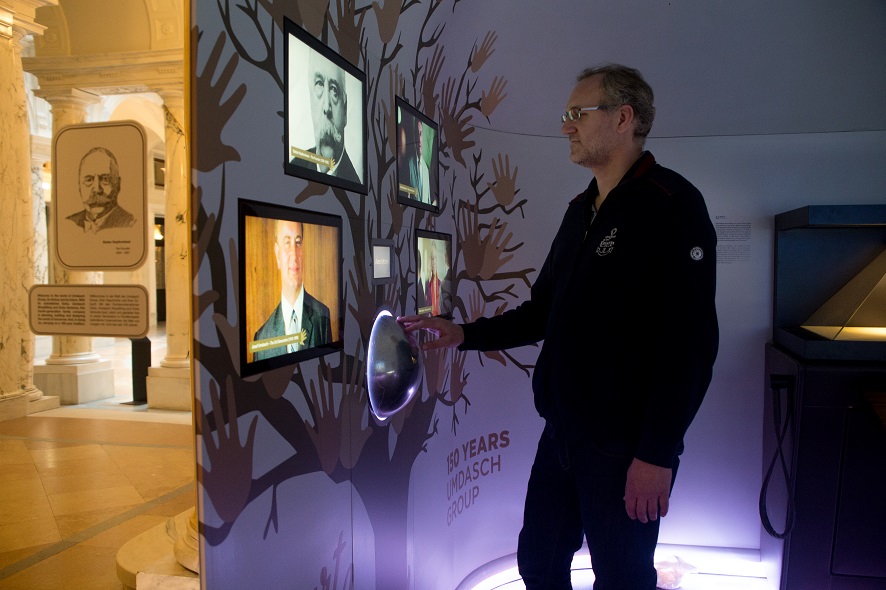
Credit: Vanessa Graf
The last installation is a sort of tree…
Claus Zweythurm: The employee tree is the logo of Umdasch’s 150th anniversary. And in this tree, we’ve integrated a globe emblematic of Umdasch’s worldwide activities. Visitors can spin this globe, and, whichever part of the world you land on, you receive information in images and videos about the company’s employees on that particular continent.
How did you come up with the ideas for the installations?
Claus Zweythurm: Our assignment was to consider what we would set up in these two pavilions. An extensive process of exchange with Umdasch yielded a concept—there should be one pavilion in which we focus more on the company, its history and what it is now; and, juxtaposed to it, a second pavilion that has a bit less to do with the company and examines the future of our world. The process was somewhat challenging since, despite the fact that we were all on the same page with the concept, we couldn’t get started with the implementation until October 2017.
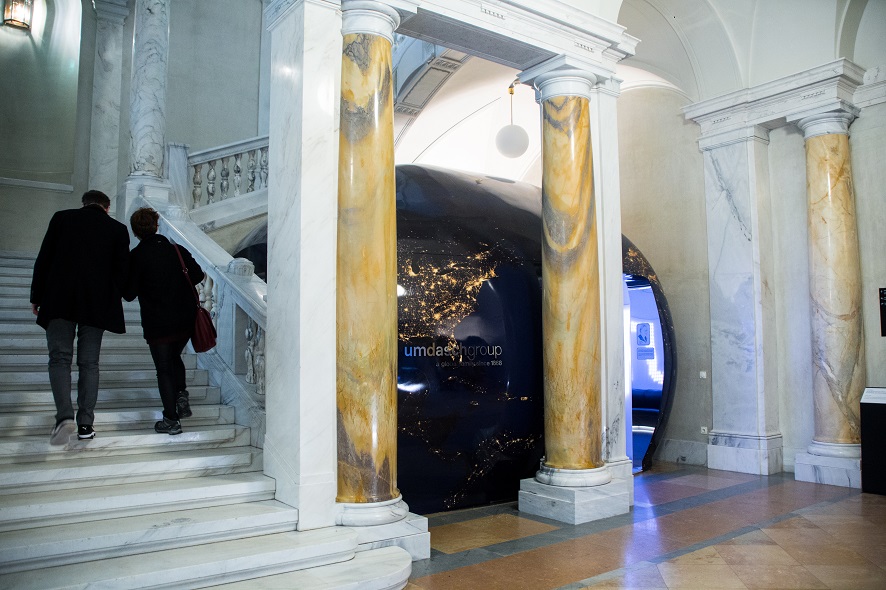
Credit: Vanessa Graf
What challenges did the work entail?
Claus Zweythurm: For one thing, the time factor was a challenge. After all, these pavilions had to be custom made. The assignment went to Nextform, a company in Wels that did a great job under considerable deadline pressure. But, as a result, we had little opportunity to do testing. The next challenge was presented by the pavilions’ oval cupolas (in contrast to round domes). For that reason, it took us four days to produce a mask for the cupolas, which is necessary so that visitors can actually see the content correctly and it’s not distorted and crooked. Presenting material on the round screen was difficult. We finally solved this problem by means of a projection. The matter of heat was also quite intriguing: How do you prevent heat from building up in the pavilion? Or how about: How do you prevent the installations from being affected by the footsteps of the installation visitors as they move about the pavilion? To do it, we had to isolate the projectors from the flooring. But this caused us some sleepless nights!

Claus Zweythurm, born 1971 in Linz, already worked at Ars Electronica at the time of the founding of the “Museum of the Future” and later at the Ars Electronica Festival, until 2000. From 1996 and 2010, he worked as a freelancer in lighting design and technology for artists, organizations, theater and opera houses, and festivals across the world. As a filmmaker, he also created short films. In 2010, he finished his education in cultural management in Vienna at the Institute of Cultural Concepts and returned to Linz, where he now conceptualizes and realizes Ars Electronica Solutions projects for events and exhibitions.
The two pavilions that Ars Electronica Solutions designed for Umdasch Group are now on display at Weltmuseum in Vienna. Complete details are available on our website.
To learn more about Ars Electronica, follow us on Facebook, Twitter, Instagram et al., subscribe to our newsletter, and check us out online at https://ars.electronica.art/news/en/.
